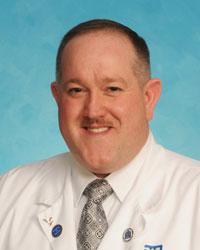
Credit: West Virginia University
Widespread COVID-19 testing may be an obvious way to control an outbreak in a long-term care facility. But communication among the facility’s staff, its residents and the residents’ family members is crucial, too.
A new study led by Carl Shrader, a physician and researcher in the Department of Family Medicine in the West Virginia University School of Medicine, revealed the role that communication played in quashing a COVID-19 outbreak at Sundale, a long-term care facility in Morgantown.
“Timely communication was challenging and made more difficult by a lack of evidence-based information and widely circulating misinformation,” said Shrader, who directs WVU’s residency program. “There is a delicate balance between rapid dissemination of accurate information with the need for personal individual discussion in an unknown situation.”
Shrader is also the medical director at Sundale, which was the epicenter of West Virginia’s COVID-19 pandemic. From the first diagnosis of COVID-19 in a Sundale resident–in March–he took a leading role in the facility’s response to the outbreak.
Before the facility was free of COVID-19, 52 residents and 19 staff members would be diagnosed with it. For five of those residents, the virus would prove fatal. But “despite the challenges of managing a COVID-19 outbreak in the absence of information, our facility’s staff, families and leadership were able to work together to ensure limited viral spread and no change in the average monthly mortality at the facility,” Shrader said.
He feels that early and widespread COVID-19 testing at the facility was key to keeping the infection rate low. As soon as the first cases came to light, the staff immediately tested all of the facility’s hundred residents, whether or not they had symptoms of COVID-19. People who tested positive were separated from the other residents and housed in the same unit to prevent the virus from spreading.
Follow-up testing in the weeks that followed identified more residents who had the virus and confirmed when residents had gotten over it.
Because test kits were scarce early in the pandemic, not every staff member at Sundale could be swabbed for the virus. Fifty-six of the 162 staff members–mostly certified nursing assistants and licensed practical nurses–were chosen for testing because of their frequent contact with residents. All other facility staff members were directed to local drive-up testing sites.
“Maintaining availability of adequate staff in all divisions to ensure safe operation of the facility was high priority,” Shrader said. “Clear communication about testing and staffing decisions was crucial in allaying fear and frustration.”
Meeting with the staff members and explaining why some of them received the rapid test while others didn’t alleviate staff members’ concerns, prevented resentment from building and fostered the spirit of teamwork that makes good resident care possible.
Staff members weren’t the only people who benefited from communication. So did residents’ family members.
At first, the facility staff tried to keep family members informed by speaking to them over the phone, but they soon discovered that they couldn’t keep up with the calls. There were simply too many people–with too many questions and concerns–to speak to them all individually.
Much of the information staff members were providing applied to multiple residents. So, with the residents’ and family members’ permission, they began using a version of Zoom that’s compliant with medical-privacy laws to talk–and listen–to many family members at once.
Not only could the staff communicate with family members this way, but the family members could share information and build relationships with each other as well.
“Families, residents and staff bonded through this unique experience, and the creative use of technology to maintain open communication aided in this,” said Courtney Pilkerton, an assistant professor of family medicine and member of the research team. “Zoom meetings continue to be popular, and many family members have requested that calls continue as they have found significant value in sharing their experiences with each other.”
But communicating with one category of people was particularly difficult: residents with dementia.
“Living with dementia means a life revolving around a structured schedule,” said Shauna Assadzandi, a medical resident at Sundale who was involved in the study. “Disruptions in that schedule can bring significant distress. If their son came every day to feed them lunch and dinner and now is not there, they may feel abandoned–not understanding why their son can no longer visit.”
Staff at the facility had to pay special attention to those residents so they could spot psychosomatic symptoms–such as lack of appetite–and address them early. Just because some residents couldn’t describe their feelings of loneliness, sadness or worry doesn’t mean they weren’t experiencing them.
“Older individuals–and, more specifically, those with dementia–don’t always verbalize concerns, and it becomes crucial to watch for physical signs of distress, including weight change and intake of food and fluids,” Assadzandi said.
“Much of our nursing staff has worked in the facility on the same unit for many years,” she said. “They know the residents well and are often the first to notice small changes in behavior. These strong connections between staff and residents allow for more rapid and individual changes to care when needed.”
###
Citation
Title: Responding to a COVID-19 Outbreak at a Long-Term Care Facility
DOI: https:/
Link: https:/
Research reported in this publication was supported by the National Institute of General Medical Sciences, a division of the National Institutes of Health, under Award Number U54GM104942. The content is solely the responsibility of the authors and does not necessarily represent the official views of NIH.
Media Contact
Cassie Thomas
[email protected]
Original Source
https:/




